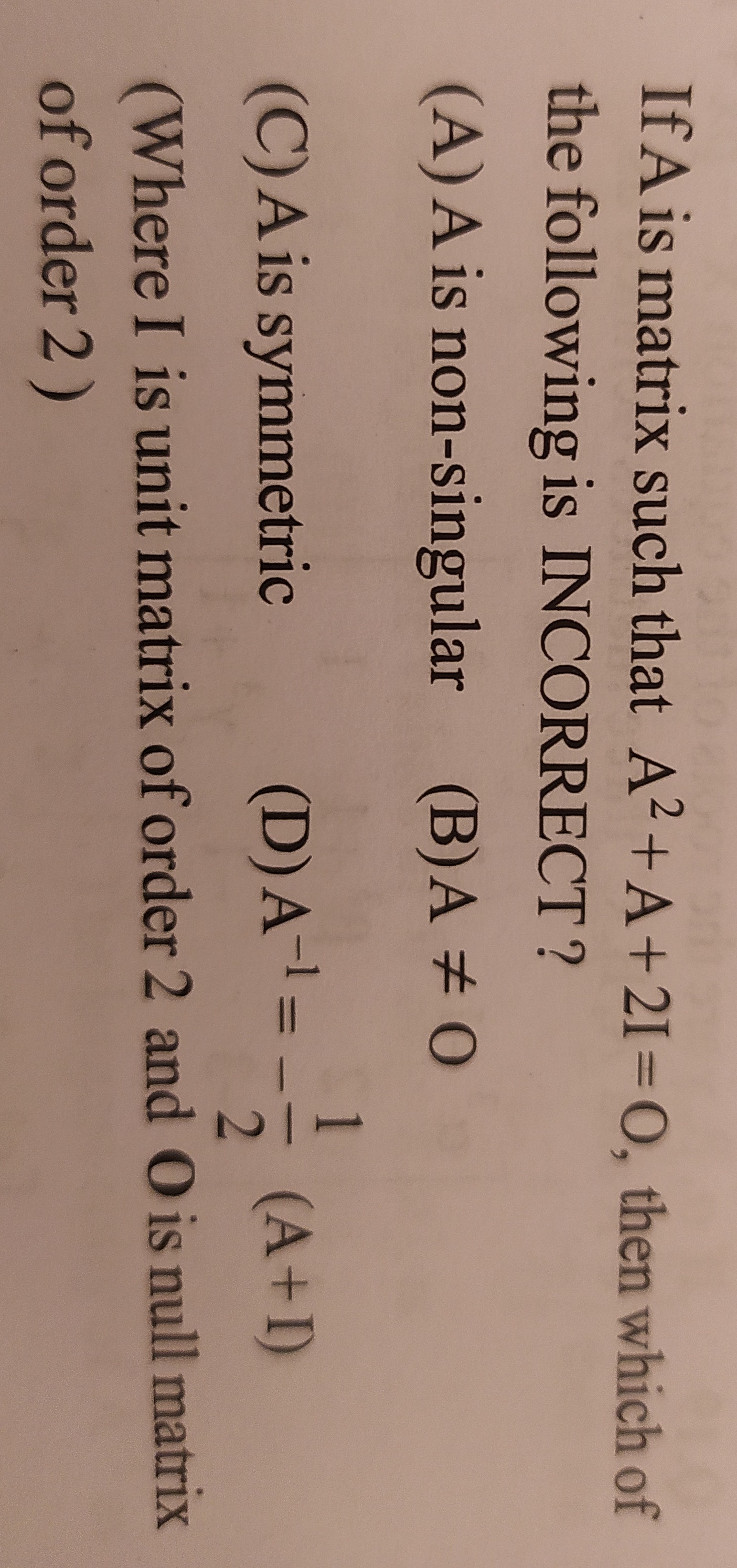Question
Question: If A is matrix such that $A^2+A+2I=0$, then which of the following is INCORRECT?...
If A is matrix such that A2+A+2I=0, then which of the following is INCORRECT?

A is non-singular
A ≠ 0
A is symmetric
A−1=−21(A+I)
(C)
Solution
The given equation is A2+A+2I=0, where A is a matrix, I is the unit matrix of order 2, and O is the null matrix of order 2.
Let's analyze each option:
(A) A is non-singular.
From the given equation, we can write A2+A=−2I. Factoring A on the left, we get A(A+I)=−2I. Taking the determinant of both sides: det(A(A+I))=det(−2I) det(A)det(A+I)=det(−2I) Since I is a 2x2 matrix, −2I=(−200−2). det(−2I)=(−2)(−2)−(0)(0)=4. So, det(A)det(A+I)=4. Since the product is 4 (which is non-zero), neither det(A) nor det(A+I) can be zero. Thus, det(A)=0, which means A is non-singular. Alternatively, from A(A+I)=−2I, we can write A(−21(A+I))=I. This shows that the inverse of A is A−1=−21(A+I). Since the inverse exists, A is non-singular. Statement (A) is correct.
(B) A ≠ 0.
If A were the null matrix O, the equation A2+A+2I=0 would become O2+O+2I=0, which simplifies to O+O+2I=O, or 2I=O. For a 2x2 matrix, 2I=(2002) and O=(0000). (2002)=(0000) is false. Thus, A cannot be the null matrix. Statement (B) is correct.
(C) A is symmetric.
A matrix A is symmetric if AT=A. The equation A2+A+2I=0 implies that A satisfies the polynomial p(x)=x2+x+2=0. By the Cayley-Hamilton theorem, the characteristic polynomial of A must be λ2+λ+2=0. The eigenvalues of A are the roots of this characteristic equation: λ=2−1±12−4(1)(2)=2−1±−7=2−1±i7. The eigenvalues are complex. If A were a real symmetric matrix, its eigenvalues must be real. Since the eigenvalues are complex, A cannot be a real symmetric matrix. In the context of JEE/NEET, matrices are generally assumed to be real unless specified otherwise. Assuming A is a real matrix, it cannot be symmetric. If A were allowed to be a complex matrix, it is possible for a complex symmetric matrix to satisfy the equation (e.g., a diagonal matrix with entries being the roots of x2+x+2=0). However, the statement "A is symmetric" typically implies it is a necessary property given the condition. Since we can find non-symmetric matrices satisfying the equation (as shown in the thought process, constructing a non-symmetric matrix with complex entries satisfying the system of equations derived from A2+A+2I=0 and AT=A is possible), the statement "A is symmetric" is not necessarily true for any matrix A satisfying the condition. Therefore, it is an incorrect statement about A in general.
(D) A−1=−21(A+I).
From the given equation A2+A+2I=0. We know from (A) that A is non-singular, so A−1 exists. Multiply the equation by A−1 on the left: A−1(A2+A+2I)=A−1O A−1A2+A−1A+A−1(2I)=O (A−1A)A+I+2A−1I=O IA+I+2A−1=O A+I+2A−1=O 2A−1=−(A+I) A−1=−21(A+I). Statement (D) is correct.
The incorrect statement is (C).
